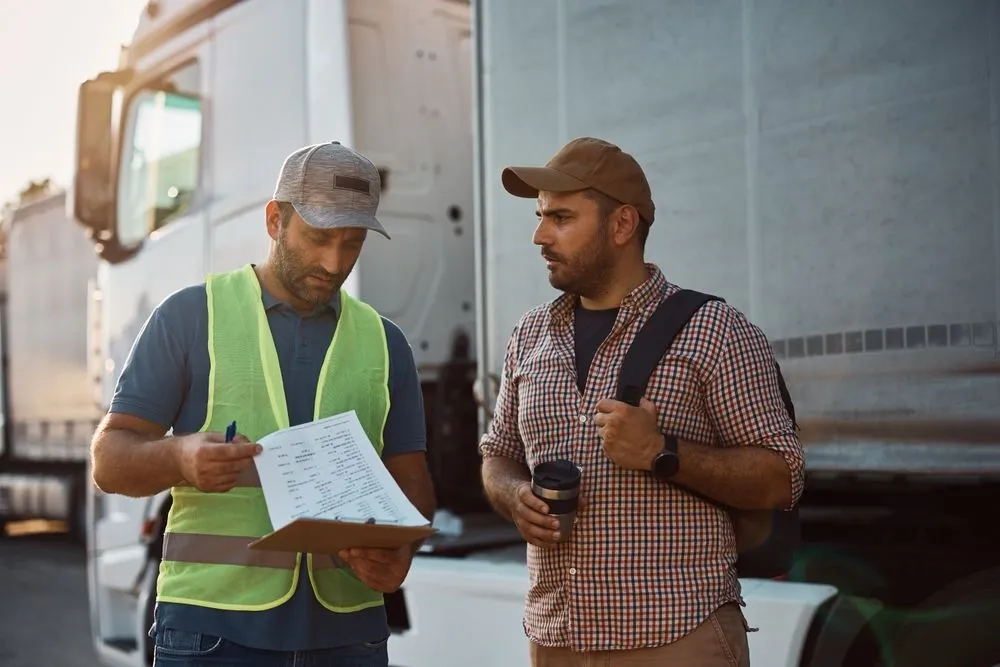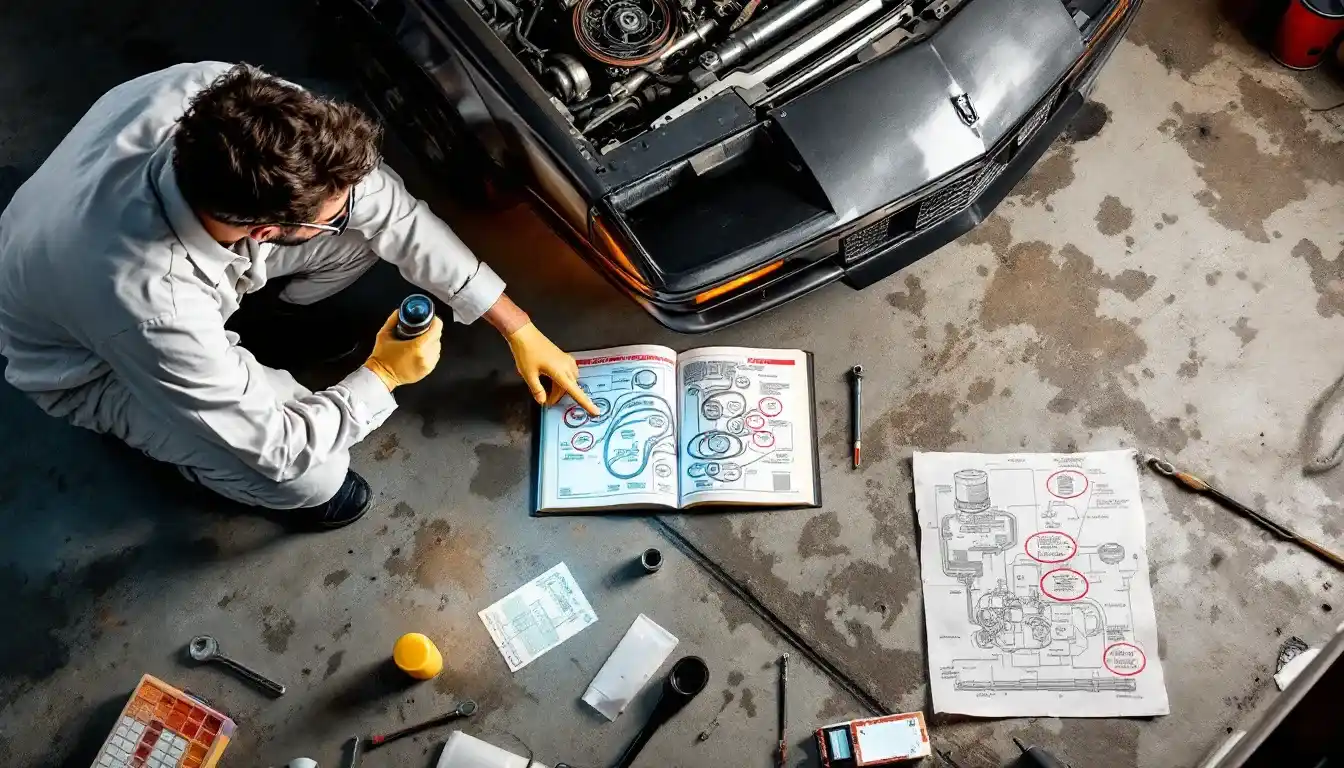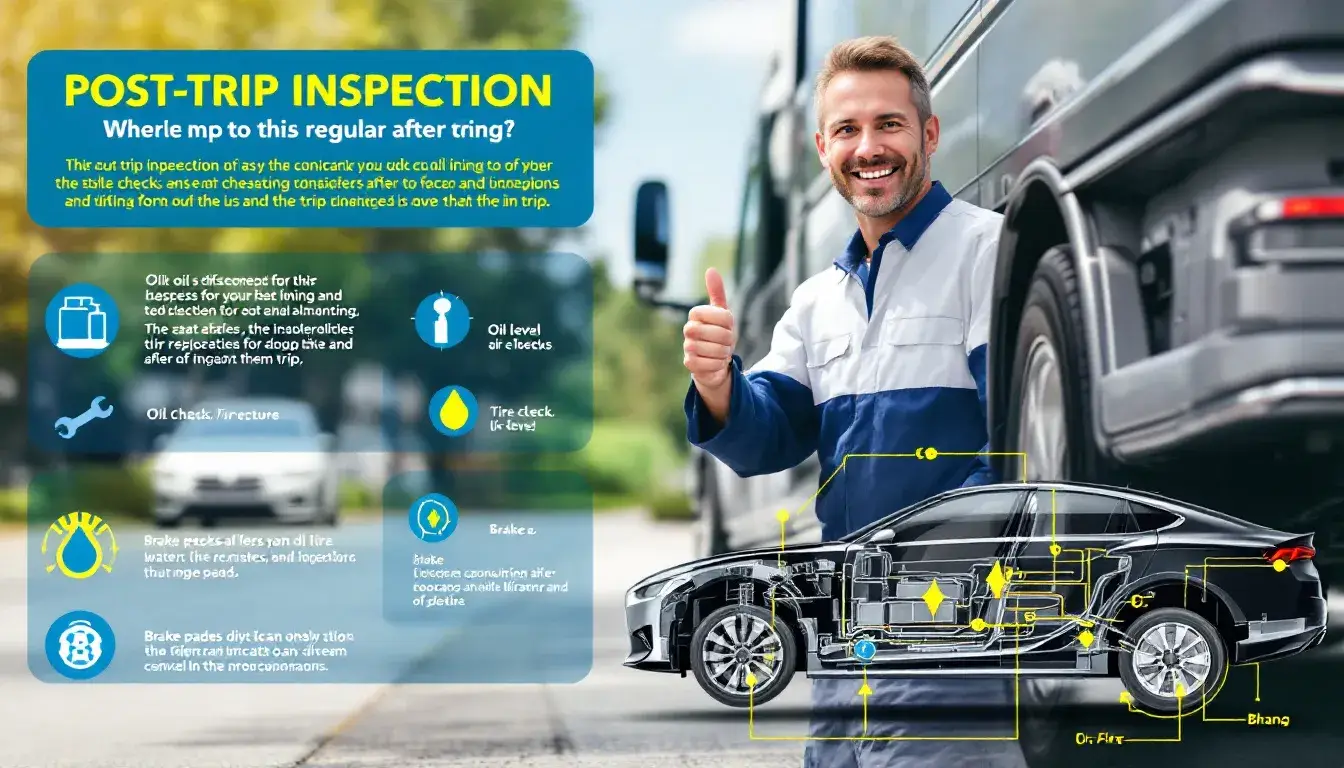
A post trip inspection is a crucial procedure for checking a vehicle’s condition after a trip to ensure safety and reliability. This process helps identify any issues that may have arisen during the journey, preventing potential accidents and breakdowns. Knowing what to look for during a post trip inspection is essential for maintaining compliance with safety regulations and ensuring the vehicle is ready for its next use.
Table Of Content
Key Takeaways
- Post-trip inspections are essential for ensuring vehicle safety and compliance with federal regulations, requiring thorough examination of critical components.
- A detailed post-trip inspection checklist, which includes brakes, fluid levels, and emergency equipment, is vital for identifying potential issues and maintaining regulatory compliance.
- Neglecting post-trip inspections can result in financial penalties and increased risk of mechanical failures, highlighting the importance of consistent inspections and accurate record-keeping.
Understanding Post Trip Inspections

A post-trip inspection is more than just a routine task; it’s a critical procedure designed to check the condition of a commercial vehicle after a trip to prevent accidents and breakdowns. These inspections are performed immediately after parking the vehicle and shutting off the engine, making them the responsibility of both safety officers and vehicle operators.
During a post-trip inspection, various critical vehicle components such as brakes, lights, and emergency equipment are thoroughly examined during a pre trip inspection. This ensures that any issues that may have arisen during the trip are identified and addressed promptly. This step ensures the vehicle’s overall safety and readiness for future use.
While post-trip inspections focus on the vehicle’s condition after a trip, they differ from pre-trip inspections, which are conducted before the vehicle is put into operation. These inspections collectively ensure vehicle safety by addressing potential issues before and after each journey.
Legal Requirements

Adhering to federal regulations is paramount for any commercial vehicle operation, and post-trip inspections are a key component of this compliance. These inspections are especially crucial for vehicles carrying passengers, as mandated by federal regulations. The Federal Motor Carrier Safety Administration (FMCSA) and the Canadian Council of Motor Transport Administrators (CCMTA) both require these inspections to be conducted at the end of each day’s work or driving shift.
Maintaining regulatory compliance with these regulations requires a detailed post-trip inspection checklist. This checklist typically includes safety checks such as verifying fluid levels, examining brakes, and ensuring emergency equipment is in good condition. Regularly performing these inspections can help catch potential compliance violations early, reducing the risk of costly penalties.
Submitting a Driver Vehicle Inspection Report (DVIR) after each inspection is crucial for maintaining compliance. These reports help document the vehicle’s condition and any issues found, providing a record that can be used during audits to demonstrate adherence to safety standards.
Elements of a Comprehensive Post Trip Inspection
A comprehensive post-trip inspection involves a thorough check of the vehicle’s various systems and components. One of the most important elements to inspect is the brake system, as a significant number of out-of-service violations are related to brake issues. Ensuring the brakes are in good condition is crucial for the vehicle’s safety and performance.
In addition to brakes, the checklist should include verifying fluid levels such as oil, coolant, and transmission fluid. Drivers should also inspect emergency equipment, including a fire extinguisher and a first aid kit, to ensure they are functional and accessible in case of an emergency.
Checking for visual defects and load security is also essential to ensure the vehicle is road-ready for its next trip.
Essential Items on the Inspection Checklist
A detailed post-trip inspection checklist is a valuable tool for ensuring all critical components are examined. This checklist should include items such as brakes, steering mechanisms, lighting devices, tires, horns, windshield wipers, mirrors, coupling devices, wheels and rims, and emergency equipment. Each of these components plays a vital role in the vehicle’s overall safety and functionality.
Additionally, it’s important to check the load to ensure it is adequately secured and free of damage. This helps prevent accidents caused by shifting or unsecured loads and ensures that the vehicle meets safety standards.
Download Our Free Post Trip Inspection Checklist
To help you conduct thorough and consistent post-trip inspections, we offer a free, downloadable post-trip inspection checklist. This comprehensive checklist covers all critical components, helping drivers maintain regulatory compliance and enhance vehicle safety.
Using this checklist ensures that all necessary inspections are completed accurately and can help identify potential issues before they lead to accidents or legal consequences.
Common Issues Found During Post-Trip Inspections

During post-trip inspections, drivers often encounter several common issues. Brake system malfunctions, tire wear or damage, and lighting system failures are among the most frequently identified problems. These issues can significantly impact vehicle safety and performance if not addressed promptly.
In addition to these, other common defects include fluid leaks, issues with steering components, mechanical issues, and problems with suspension systems. Regular post-trip inspections help mechanics identify and fix these issues before they escalate, reducing downtime and repair costs.
By addressing these problems early, drivers can help ensure their vehicle operated remain safe and reliable.
Best Practices for Conducting Post-Trip Inspections

To conduct effective post-trip inspections, drivers should adopt a structured, step-by-step method. This approach minimizes the chances of overlooking any critical checks. Establishing a consistent routine for inspections helps ensure thoroughness and reduces the risk of missing important elements.
A well-conducted post-trip inspection should mirror the pre-trip checklist but exclude checks on hot components or fluids to ensure safety. Taking approximately 10-15 minutes for a post-trip inspection is advisable to ensure all areas are adequately checked.
Maintaining cleanliness in the vehicle’s cab can also reflect overall vehicle maintenance quality and diligence.
The Role of Driver Vehicle Inspection Reports (DVIR)
The Driver Vehicle Inspection Report (DVIR) plays a crucial role in ensuring vehicle safety and compliance. Drivers must ensure that DVIRs accurately reflect any issues found during inspections to avoid penalties. Accurate logs serve as proof of compliance during inspections, protecting operators from legal repercussions.
It’s important to report any irregularities found during the inspection to dispatch so that potential vehicle issues can be addressed promptly. Training should focus on the specific items that need to be examined during post-trip inspections and what constitutes acceptable or unacceptable vehicle conditions.
Consequences of Skipping Post Trip Inspections
Neglecting post-trip inspections can lead to significant financial penalties, including fines that vary based on the severity and nature of the violation. Both the driver and the company may face hefty fines and potential legal liabilities for not conducting or documenting required post-trip inspections.
Furthermore, skipping post-trip inspections increases the risk of mechanical failures, which can cause accidents and lead to injuries or fatalities. Regular inspections help in detecting potential compliance violations that may lead to fines or penalties.
Thorough post-trip inspections help drivers prevent costly and dangerous consequences.
Maintaining Accurate Logs and Records
Keeping precise records of post-trip inspections is essential for compliance with legal standards and helps prevent penalties. Failing to maintain proper logs can lead to increased scrutiny from regulatory agencies. Both electronic and paper logs should be regularly updated to reflect the status of inspections accurately.
The DVIR is an essential record that can be used during audits to demonstrate adherence to safety standards. By maintaining accurate logs and records, drivers and companies can ensure compliance and avoid costly penalties.
Benefits of Regular Post Trip Inspections

Regular post-trip inspections offer numerous benefits. A thorough inspection helps identify minor issues before they escalate into major problems, ensuring vehicle safety and reliability. Inspecting the interior of the vehicle, including the brakes and wipers, is crucial for safety.
Performing regular post-trip inspections can help ensure that repairs are made promptly, reducing the chances of costly delays in fleet operations. Regular maintenance can significantly reduce the likelihood of finding defects during post-trip inspections. By documenting inspection findings, drivers can better track vehicle maintenance issues over time.
Summary
In conclusion, post-trip inspections are a vital aspect of vehicle safety and compliance. By understanding the legal requirements, conducting thorough inspections, and maintaining accurate logs, drivers can help ensure their vehicles remain safe and road-ready. Regular post-trip inspections not only prevent accidents but also contribute to overall fleet efficiency and reduce operational downtimes.
We encourage all drivers and operators to adopt diligent inspection practices to enhance safety, compliance, and vehicle longevity. Remember, a well-maintained vehicle is not just a regulatory requirement; it’s a commitment to safety and reliability.
Frequently Asked Questions
What is a post-trip inspection?
A post-trip inspection is essential for assessing a commercial vehicle’s condition after a journey, helping to prevent accidents and ensure safe operation. Conducting this inspection regularly is crucial for maintaining vehicle safety and reliability.
Why are post-trip inspections legally required?
Post-trip inspections are legally required to ensure compliance with FMCSA and CCMTA regulations, allowing for the early detection of potential safety issues and violations. This proactive measure enhances road safety and accountability in transportation.
What should be included in a post-trip inspection checklist?
A thorough post-trip inspection checklist should include brakes, steering mechanisms, lighting devices, tires, and emergency equipment to ensure safety and vehicle reliability. Consistently using this checklist can prevent accidents and costly repairs.
What are the consequences of skipping post-trip inspections?
Skipping post-trip inspections can expose you to financial penalties, legal liabilities, and a heightened risk of mechanical failures and accidents. It is crucial to prioritize these inspections to ensure safety and compliance.
How can accurate logs and records help in post-trip inspections?
Accurate logs and records play a crucial role in post-trip inspections by ensuring compliance with legal standards and serving as documentation during audits. This thorough record-keeping helps prevent penalties and enhances accountability within the process.

